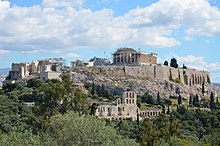
In a society, high culture encompasses cultural objects of aesthetic value which a society collectively esteems as being exemplary works of art,[1] as well as the intellectual works of literature and music, history and philosophy which a society considers representative of their culture.[2]
In popular usage, the term high culture identifies the culture either of the upper class (an aristocracy) or of a status class (the intelligentsia); high culture also identifies a society’s common repository of broad-range knowledge and tradition (folk culture) that transcends the social-class system of the society. Sociologically, the term high culture is contrasted with the term low culture, which comprises the forms of popular culture characteristic of the less-educated social classes, such as the barbarians, the Philistines, and hoi polloi (the masses),[3] though very often also enjoyed by the upper classes.

Matthew Arnold introduced the term high culture in the book Culture and Anarchy (1869). The Preface defines culture as "the disinterested endeavour after man’s perfection" pursued, obtained, and achieved by effort to "know the best that has been said and thought in the world".[4] Such a literary definition of high culture also includes philosophy. Moreover, the philosophy of aesthetics proposed in high culture is a force for moral and political good. Critically, the term "high culture" is contrasted with the terms "popular culture" and "mass culture".[5]
In Notes Towards the Definition of Culture (1948), T. S. Eliot said that high culture and popular culture are necessary and complementary parts of the culture of a society. In The Uses of Literacy (1957), Richard Hoggart presents the sociologic experience of the working-class man and woman in acquiring the cultural literacy, at university, which facilitates social upward mobility. In the U.S., Harold Bloom and F. R. Leavis pursued the definition of high culture, by way of the Western canon of literature. Media theorist Steven Johnson writes that, unlike popular culture, "the classics—and soon to be classics—are in their own right descriptions and explanations of the cultural systems that produced them." He says that "a crucial way in which mass culture differs from high art" is that individual works of mass culture are less interesting than the broader cultural trends which produced them.[6]
- ^ Williams, Raymond. Keywords: A Vocabulary of Culture and Society (1983) Rev. Ed. p. 92.
- ^ Williams, Raymond. Keywords: A Vocabulary of Culture and Society (1983) Rev. Ed. p. 91–92.
- ^ Gaye Tuchman, Nina E. Fortin (1989). "ch. 4 The High-Culture Novel". Edging Women Out: Victorian Novelists, Publishers and Social Change. Routledge. ISBN 978-0-415-03767-9.
- ^ Arnold, Matthew (1869). Culture and Anarchy. The Cornhill Magazine.
- (2003) Culture and Anarchy at Project Gutenberg
- ^ The Encyclopedia of Philosophy (1967) Volume 1. p. 167.
- ^ Steven Johnson (6 April 2006). Everything Bad is Good for You: How Popular Culture is Making Us Smarter. Penguin Books Limited. p. 203. ISBN 978-0-14-193312-2.